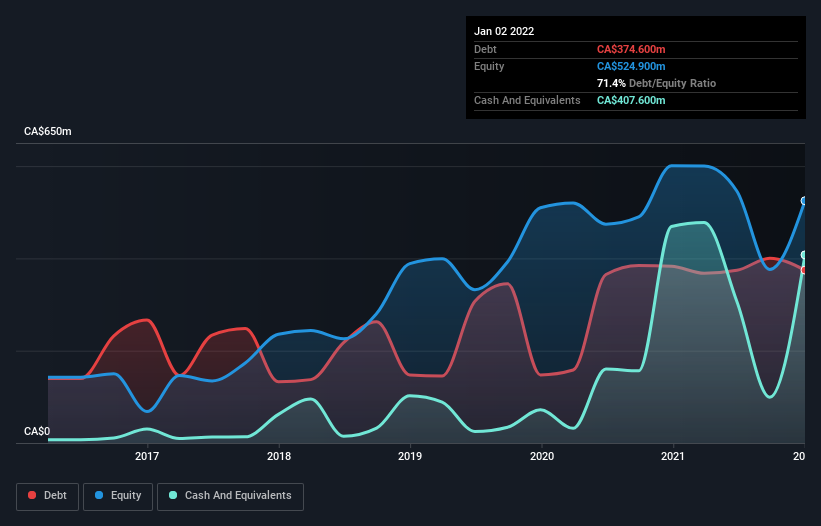Canada Goose Holdings (TSE:GOOS) Seems To Use Debt Rather Sparingly
Some say volatility, rather than debt, is the best way to think about risk as an investor, but Warren Buffett famously said that 'Volatility is far from synonymous with risk.' When we think about how risky a company is, we always like to look at its use of debt, since debt overload can lead to ruin. As with many other companies Canada Goose Holdings Inc. (TSE:GOOS) makes use of debt. But the real question is whether this debt is making the company risky.
Why Does Debt Bring Risk?
Debt is a tool to help businesses grow, but if a business is incapable of paying off its lenders, then it exists at their mercy. In the worst case scenario, a company can go bankrupt if it cannot pay its creditors. However, a more frequent (but still costly) occurrence is where a company must issue shares at bargain-basement prices, permanently diluting shareholders, just to shore up its balance sheet. Of course, debt can be an important tool in businesses, particularly capital heavy businesses. The first thing to do when considering how much debt a business uses is to look at its cash and debt together.
Check out our latest analysis for Canada Goose Holdings
How Much Debt Does Canada Goose Holdings Carry?
As you can see below, Canada Goose Holdings had CA$374.6m of debt, at January 2022, which is about the same as the year before. You can click the chart for greater detail. However, it does have CA$407.6m in cash offsetting this, leading to net cash of CA$33.0m.

A Look At Canada Goose Holdings' Liabilities
According to the last reported balance sheet, Canada Goose Holdings had liabilities of CA$390.1m due within 12 months, and liabilities of CA$651.7m due beyond 12 months. On the other hand, it had cash of CA$407.6m and CA$108.5m worth of receivables due within a year. So its liabilities outweigh the sum of its cash and (near-term) receivables by CA$525.7m.
Since publicly traded Canada Goose Holdings shares are worth a total of CA$3.09b, it seems unlikely that this level of liabilities would be a major threat. However, we do think it is worth keeping an eye on its balance sheet strength, as it may change over time. While it does have liabilities worth noting, Canada Goose Holdings also has more cash than debt, so we're pretty confident it can manage its debt safely.
Notably, Canada Goose Holdings's EBIT launched higher than Elon Musk, gaining a whopping 135% on last year. The balance sheet is clearly the area to focus on when you are analysing debt. But it is future earnings, more than anything, that will determine Canada Goose Holdings's ability to maintain a healthy balance sheet going forward. So if you want to see what the professionals think, you might find this free report on analyst profit forecasts to be interesting.
Finally, a company can only pay off debt with cold hard cash, not accounting profits. While Canada Goose Holdings has net cash on its balance sheet, it's still worth taking a look at its ability to convert earnings before interest and tax (EBIT) to free cash flow, to help us understand how quickly it is building (or eroding) that cash balance. Over the last three years, Canada Goose Holdings recorded free cash flow worth a fulsome 86% of its EBIT, which is stronger than we'd usually expect. That positions it well to pay down debt if desirable to do so.
Summing up
While Canada Goose Holdings does have more liabilities than liquid assets, it also has net cash of CA$33.0m. And it impressed us with free cash flow of CA$184m, being 86% of its EBIT. So is Canada Goose Holdings's debt a risk? It doesn't seem so to us. When analysing debt levels, the balance sheet is the obvious place to start. However, not all investment risk resides within the balance sheet - far from it. For example - Canada Goose Holdings has 1 warning sign we think you should be aware of.
If you're interested in investing in businesses that can grow profits without the burden of debt, then check out this free list of growing businesses that have net cash on the balance sheet.
New: AI Stock Screener & Alerts
Our new AI Stock Screener scans the market every day to uncover opportunities.
• Dividend Powerhouses (3%+ Yield)
• Undervalued Small Caps with Insider Buying
• High growth Tech and AI Companies
Or build your own from over 50 metrics.
Have feedback on this article? Concerned about the content? Get in touch with us directly. Alternatively, email editorial-team (at) simplywallst.com.
This article by Simply Wall St is general in nature. We provide commentary based on historical data and analyst forecasts only using an unbiased methodology and our articles are not intended to be financial advice. It does not constitute a recommendation to buy or sell any stock, and does not take account of your objectives, or your financial situation. We aim to bring you long-term focused analysis driven by fundamental data. Note that our analysis may not factor in the latest price-sensitive company announcements or qualitative material. Simply Wall St has no position in any stocks mentioned.
About TSX:GOOS
Canada Goose Holdings
Designs, manufactures, and sells performance luxury outerwear, apparel, footwear, and accessories for men, women, youth, children, and babies.
Reasonable growth potential with mediocre balance sheet.
Similar Companies
Market Insights
Community Narratives



